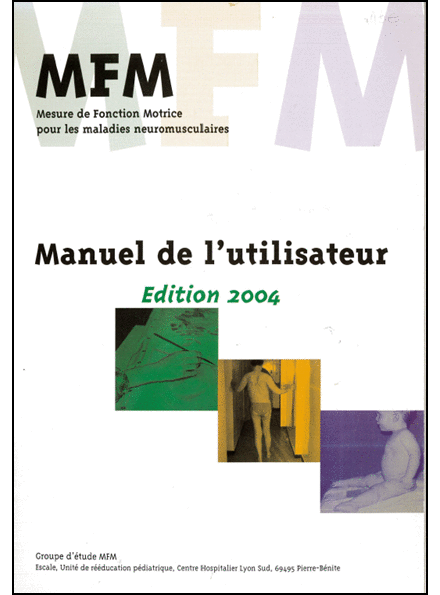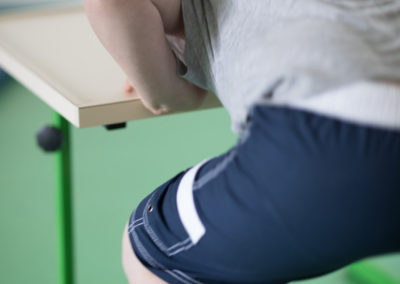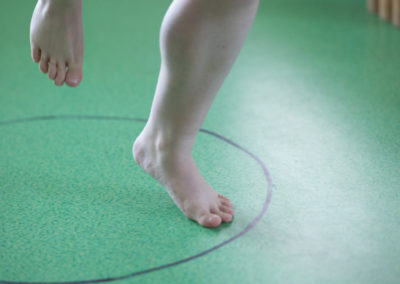Learn more about the mfm
History
The MFM adventure

The process of development and validation of the MFM began in 1998.
A provisional scale consisting of 75 items was sent to 166 national and international groups. The criticisms expressed by 47 of these groups (Physical Medicine, Neurology and Pediatrics from both Europe and North America) were then analyzed by a French-speaking study group which met for the first time in September 1998. The first version, which included 51 items and written in French, was submitted for validation. The validation study for this MFM first version took place between May 2000 and February 2001 and involved the participation of 17 centers and 376 subjects.
The lessons learned from the results made it possible to produce a 2nd version with 32 items, which became the final version of the MFM-32.
In 2006, demands from researchers and clinicians led to the validation of the MFM in children under 6 years to be considered.
A study in 2007 in 4 French sites with 191 healthy children demonstrated that some items were not suitable for a child undergoing psychomotor development.
By eliminating items that were failed by more than 80% of the healthy children tested, a reduced MFM with 20 items was defined.
MFM-32 Princeps Study
The validation study for the final version of the MFM-32 took place between May 2002 and March 2003. It involved 303 subjects aged from 6 to 60 who were affected by progressive Duchenne or Becker muscular dystrophy, facio-scapulo-humeral muscular dystrophy, limb-girdle muscular dystrophies, congenital muscular dystrophy, congenital myopathies, myotonic dystrophy, spinal muscular atrophies and hereditary sensory-motor neuropathy. The results of this validation study demonstrated the following metrological characteristics:
• Inter- and intra-observer reliability ranging from good to excellent for all items
• Construct validity by factorial analysis (identification of the 3 motor functions D1, D2, D3)
• Validity against criteria
• Discriminant validity: depending on diagnosis and severity
The MFM-32 validation study was published in 2015 in the journal Neuromuscular disorders
MFM-20 Princeps Study
The sensitivity to change of the MFM
The sensitivity to changes of MFM was studied between 2003 and 2004 in 152 neuromuscular patients (Bérard et al., 2006; Vuillerot et al., 2012), and specifically for Duchenne muscular dystrophy (Vuillerot et al., 2010) and spinal muscular atrophy (Vuillerot et al., 2013).
A complete list of the MFM sensitivity to changes studies can be found in the publication section.
Target population
The MFM is a quantitative scale applicable to all patients with neuromuscular disease, regardless of the severity of the motor impairment. The MFM is thus applicable to both walking and non-walking patients.
The MFM makes it possible to:
- clarify the symptomatology and evolution of neuromuscular diseases
- objectify the impact of therapeutic measures
- guide rehabilitative and adaptive measures
- facilitate communication between the different stakeholders involved in medical care
- select homogeneous groups of patients for therapeutic trials
Functional domains assesed
- D1: Standing and transfers (13 items for the MFM-32 and 8 items for the MFM-20);
- D2: Axial and proximal motor function (12 items for the MFM-32 and 8 items for the MFM-20);
- D3: Distal motor function (7 items for the MFM-32 and 4 items for the MFM-20)
Item Scoring
To facilitate the analysis of the subject’s performance, a maximum of two motor function components are taken into account for the scoring of each item. For example, in some items the examiner may control the range of the movement, and in others the position of a joint and the transition from one position to another.
There is a generic item scoring defined by:
0: Cannot perform the task, or cannot maintain the starting position
1: Initiated the task
2: Performs the movement incompletely, or completely but imperfectly (compensatory movements, position maintained for an insufficient duration of time, slowness, uncontrolled movement)
3: Performs the task fully and “normally”; the movement is controlled, mastered, directed and performed at constant speed
Starting position / Installation of the Subject
The starting position is important to consider. If this position cannot be achieved, the score for the item is 0.
For items 1 to 10, the subject should be positioned on a mat or a wide examination table, lying flat, then seated.
For items 11, 12 and 24 to 32, the subject should be able to stand on the floor or on a mat. A subject who cannot stand, even with support, obtains a score of 0 for these 11 items.
For items 14 to 23, the subject may be seated in a wheelchair; the examiner should remove the armrests and the tray, which can be replaced by a table adjusted to the subject’s height.
Duration of completion
Calculation of scores
The scores are expressed as a percentage in relation to the maximum score.
The score for each domain (D1, D2 and D3) corresponds to the sum of the scores obtained by the subject for the items in that domain divided by the maximum score for the domain and multiplied by 100.
For the MFM-32, the total score is the sum of all the scores (in all the domains) divided by 96 and multiplied by 100. For the MFM-20 the total score is the sum of all the scores divided by 60 and multiplied by 100.
The user manual
The user manual is an essential tool for a rigorous scoring of each item and should be consulted throughout the MFM validation process. It gives all the information necessary for the validation of each of the 32 items (description of the starting position, instructions for validation) and the necessary details or scoring aids.
The manual is regularly enriched by user feedback, training sessions and translations. The first edition in French language dates from 2004, and the 4th edition, the most recent, can be downloaded in the User manual section.
Many translations are also available for download.
The Scoring Sheet
Necessary equipment
During the follow-up of a subject, it is preferable to always use the same equipment.
The equipment required for the MFM validation process is:
- A physiotherapy mat or a wide examination table
- Cushions for comfortable positioning of the head and limbs
- A table set at a height that allows the subject to have their forearms resting on the table when seated and elbows flexed at 90°
- A chair (with adjustable height if possible). The height of the seat should be such that the subject’s feet touch the floor when they are seated, with the hips and knees flexed at 90°
- Space within a corridor to enable free movement of 10 meters
- A line traced on the floor, approximately 2 centimeters wide and 6 meters long
- A stopwatch
- A CD glued on an A4 cardboard sheet, advertising side against the sheet. The edge of the small circle and the circumference of the CD should be colored with a felt-tip pen
- 10 coins about 20 mm in diameter and 2 mm thick (10 euro cents or equivalent)
- A tennis ball with a happy face drawn on it
- A pencil
- Sheets of paper of size A 4 or equivalent of 70g or 80g










